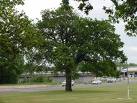Quercus Stellata Tree Information
Images of Quercus Stellata:






Quercus Stellata grows in the following 28 states and provinces:
Alabama, Arkansas, Connecticut, Delaware, Florida, Georgia, Illinois, Indiana, Iowa, Kansas, Kentucky, Louisiana, Maryland, Massachusetts, Mississippi, Missouri, New Jersey, New York, North Carolina, Ohio, Oklahoma, Pennsylvania, Rhode Island, South Carolina, Tennessee, Texas, Virginia, West VirginiaInformation about Quercus Stellata:
The Quercus Stellata is commonly known as the Bottom-land Post Oak, Bottomland Post Oak, Boynton Post Oak, Cross Oak, Delta Post Oak, Drummond Post Oak, Dwarf Post Oak, Iron Oak, Mississippi Valley Oak, Post Oak, Runner Oak, Sand Post Oak, Sandhill Post Oak, Scrubby Post Oak as well as Yellow Oak.
The currently accepted scientific name of post oak is Quercus stellata Wangenh. . Post oak has been placed within the subgenus Lepidobalanus, or white oak group . The following three varieties are recognized : Quercus stellata var. margaretta (Ashe) Sarg., sand post oak Quercus stellata var. paludosa Sarg., Delta post oak Quercus stellata var. stellata, post oak Identification of post oak is difficult because of its many growth forms. At times, local populations have been given species or varietal status. A rhizomatous dwarf post oak that grows near Lufkin, Texas, is called Boynton post oak (Q. boyntonii). Drummond post oak, which grows in deep sands of Texas, is thought to be a hybrid between post oak and sand post oak . It has also been considered a species (Q. drummondii) by some authors . Post oak hybridizes with the following species : x Q. alba (white oak): Q. X fernowii Trel. x Q. bicolor (swamp white oak): Q. X substellata Trel. x Q. durandii (Durand oak): Q. X macnabiana Sudw. x Q. havardii (Havard oak) x Q. lyrata (overcup oak): Q. X sterrettii Trel. x Q. macrocarpa (bur oak): Q. X guadalupensis Sarg. x Q. minima (dwarf live oak): Q. X neo-tharpii A. Camus x Q. mohriana (Mohr oak) x Q. prinoides (dwarf chinkapin oak): Q. X stelloides Palmer x Q. prinus (chestnut oak): Q. X bernardiensis W. Wolf x Q. virginiana (live oak): Q. X harbisonii Sarg. Post oak is widespread in the eastern and central United States from southeastern Massachusetts, Rhode Island, southern Connecticut, and extreme southeastern New York; south to central Florida; and west to southeastern Kansas, western Oklahoma, and central Texas. In the Midwest, it grows as far north as southeastern Iowa, central Illinois, and southern Indiana. It is an abundant tree in coastal plains and the Piedmont and extends into the lower slopes of the Appalachian Mountains . Sand post oak occurs from southeastern Virginia south to central Florida and west to Missouri, eastern Oklahoma, and south and central Texas . It is most common on coastal plains and is scattered in the Piedmont . Delta post oak occurs in bottomlands in eastern Texas and in the Mississippi River valley in western Mississippi, southeastern Arkansas, and Louisiana .Post oak occurs as a dominant tree in savannas and in forests adjacent to grasslands. It forms pure stands or mixed stands with blackjack oak (Quercus marilandica) in the prairie transition area of central Oklahoma and Texas, where the eastern deciduous forests grade into the drier western grasslands . Sand post oak codominates with bluejack oak (Q. incana) and blackjack oak on the slightly more mesic midslopes of sandhills, downslope from the xeric ridges that support turkey oak (Q. laevis) . The following published classifications list post oak as a dominant or codominant species: Forest vegetation of the lower Alabama Piedmont The natural communitites of South Carolina Forest vegetation of the Big thicket, southeast Texas Eastern Deciduous Forest Old-growth forests within the Piedmont of South Carolina The natural forests of Maryland: an explanation of the vegetation map of Maryland Some of the information provided here is attributed to:Carey, Jennifer H. 1992. Quercus stellata. In: Fire Effects Information System, [Online]. U.S. Department of Agriculture, Forest Service, Rocky Mountain Research Station, Fire Sciences Laboratory (Producer). , available at the USDA Fire Effects Information System (FEIS) website